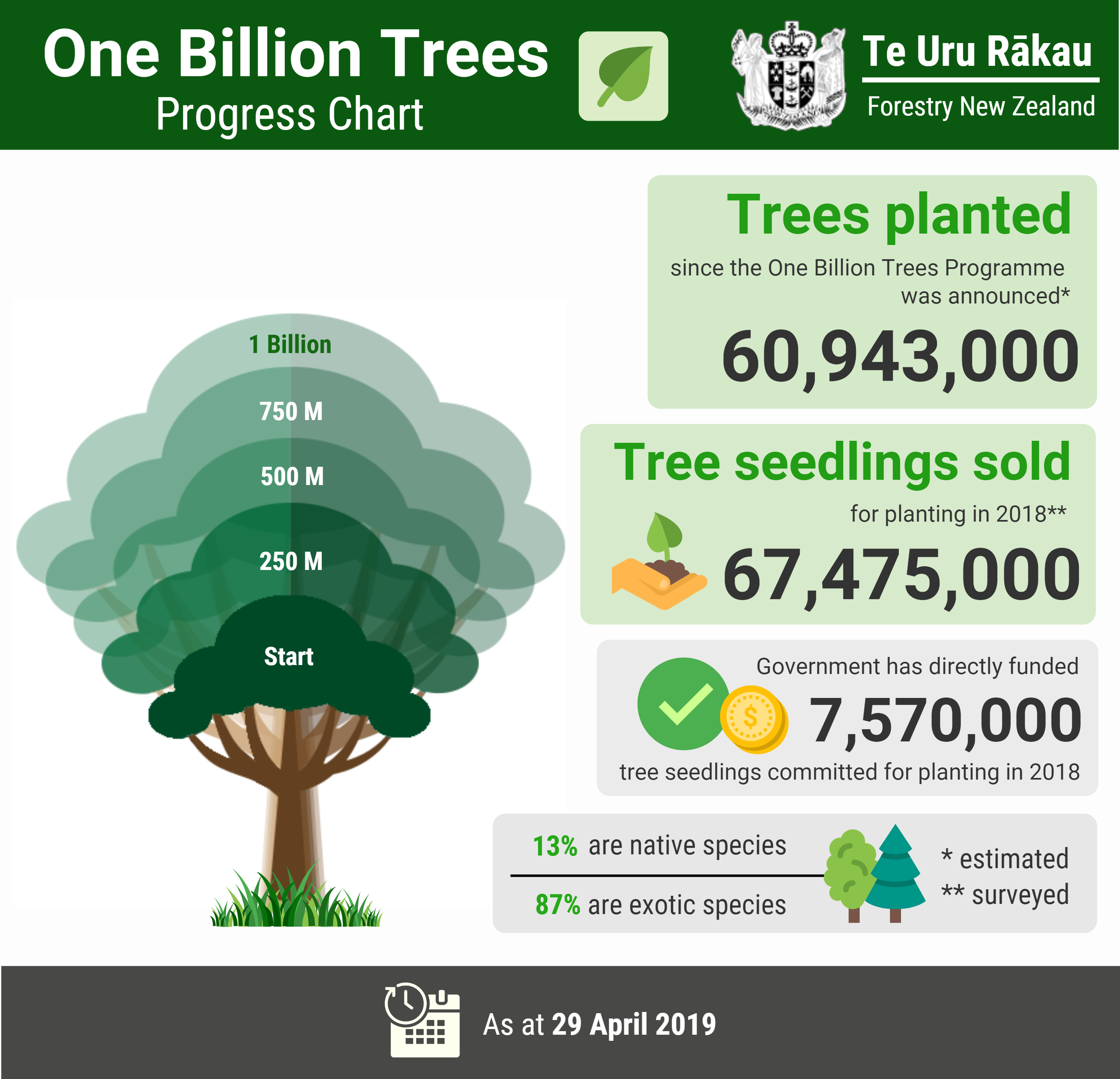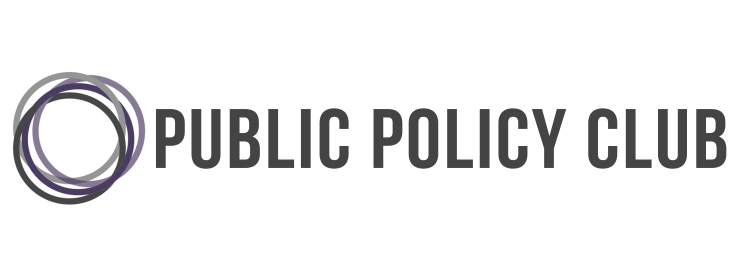By Paul Simperingham
What is the One Billion Trees Programme?
The incumbent coalition government has set the goal of planting one billion trees in New Zealand by 2028 [1]. The initiative is led by Te Uru Rakau (Forestry New Zealand) and funded by the Provincial Growth Fund, a three billion dollar fund for investment in regional economic development over a three year period [2]. $240 million is allocated to Direct Landowner Grants and Partnership Grants [3]. The two grants target different groups in New Zealand, but are both intended to fund increased tree plantings – specifically 50 million trees a year – in addition to the existing 50 million already planted by the forestry industry. Over ten years, if successful, this would add up to the one billion new trees planted.
Who Are the Key Players?
Te Uru Rakau is the main organisation responsible for the implementation of the programme. Te Uru Rakau is assisted by the Forestry Ministerial Advisory Group, established to provide advice on collaboration between the forestry industry and the Government. The group is comprised of ten independent forestry experts and meets four times a year [4].
The Hon Shane Jones is the leading figure of the programme. He holds the titles of Minister of Forestry, Minister of Infrastructure, and Minister of Regional Economic Development [5]. Another key individual is Hon Damien O’Connor, whose relevant titles include Minister of Agriculture and Minister for Rural Communities [6]. On the other side of the House, the National Party’s Hon Paul Goldsmith is the spokesperson for Economic Regional Development, Alastair Scott for Forestry, and Matt King for Rural Communities [7].
In the private sector, PF Olsen is a leading provider of independent forestry services in New Zealand and has a website dedicated entirely to working with landowners who would like to take advantage of the grants [8].
https://www.stuff.co.nz/national/politics/98491546/shane-jones–minister-of-trees
Direct Landowner Grants
The Direct Landowner Grants are focused on incentivising landowners to plant trees of specific types, namely indigenous mix, manuka/kanuka, indigenous natural regeneration, and exotic [9]. The grant rates range from $1,000 per hectare for indigenous natural generation (with a minimum of five hectares) to an invaluable $4,000 for an indigenous mix [10]. Further top-up amounts are available for tree planting on areas of land with a high erosion risk, due to the benefits on the improved stability of the environmental landscape [11].
A statement from Jones claims that 700 enquiries have been made to the fund from independent landowners (as of April 5th, 2019) [12]. It is yet to be seen whether this figure will convert into significant numbers of Direct Landowner Grants being issued.
Partnership Grants
Partnership Grants are designed to facilitate partnerships between organisations and groups for projects or initiatives that will lead to more trees being planted. These projects include research, innovation, and sector development. Key aspects of the criteria used to assess the eligibility of projects for the Partnership Grants include a positive effect on productivity in the forestry sector, enhanced ability of Māori to utilise their land and forestry resources, and commitment to co-funding of at least 50% dedicated to the initiative [13].
As of April 5th, 2019, there have been twenty-one joint ventures signed between Te Uru Rakau and New Zealand landowners. One of the more significant of these joint ventures is with Te Uri o Hau, a hapu of Ngati Whatua [14]. If successful, it will result in 2,843 hectares of plantation forestry planted in Kaipara and around 800 hectares in Hokianga [15].

https://www.mpi.govt.nz/funding-and-programmes/forestry/planting-one-billion-trees/
Benefits and Successes
The main benefits of the programme, if successfully implemented, are outlined by Hon Shane Jones as the creation of sustainable jobs throughout the regions, progress towards meeting carbon emissions targets, more sustainable Māori Maori land use, and mitigation of land erosion issues [16].
The specific carbon emissions reduction targets that the programme could help meet are the goals of emissions reduction to 30% below 2005 levels by 2030, and 50% below 1990 levels by 2050 [17]. These targets come from the 2015 Paris Agreement in late 2015 [18], which despite although the agreement lackings penalties for non-compliance, are important to ensure New Zealand’s reputation as a clean, green paradise. This reputation is essential because, as of the year ending March 2018, tourism directly contributed to 6.1% of GDP and employed 8% of the workforce [19].
Te Uru Rakau has a live counter on their website of the estimated quantity of trees planted in New Zealand, as well the proportion of those trees that have been directly funded by the government since the announcement of the programme. As of April 29th, 2019, the total number of trees planted stands at 60,943,000, and the amount funded by the government is 7,570,000 [20].

https://www.teururakau.govt.nz/funding-and-programmes/forestry/planting-one-billion-trees/tracking-progress-of-the-one-billion-trees-programme/
Problems and Criticisms
The One Billion Trees Programme is not without its detractors. It was labelled a “fanciful mirage” by National Party leader Hon Simon Bridges [21]. Critics of the project tend to question the government’s ability to execute the policy as opposed to the ideals of the programme itself. Though there is a bipartisan acknowledgement that planting more trees is a good thing, conflict arises when implementing plans to meet this goal. Alistair Scott, (National Party Spokesperson for Forestry), stated that “We all want healthy, diverse forests, strong logging and local wood processing industries and progress on reducing greenhouse gases. But these things don’t happen by chance. It takes responsible policy mechanisms, it takes a plan and it takes hard work” [22].
The One Billion Trees Programme is a ten-year project with considerable environmental, economic, and social benefits for New Zealand – if successful. If unsuccessful, it would represent one of the most significant failures for the Coalition Government to date, especially for New Zealand First. The ability of key government departments and ministers to execute the programme is the biggest unknown factor that will determine the level of success as we head into the future. Regardless of the outcome, the impacts will be felt by people of all groups in New Zealand society: he waka eke noa – we’re all in this together.
[1] https://www.mpi.govt.nz/funding-and-programmes/forestry/planting-one-billion-trees/
[2] https://www.growregions.govt.nz/about-us/the-provincial-growth-fund/
[3] Ibid
[5] https://www.beehive.govt.nz/minister/hon-shane-jones
[6] https://www.labour.org.nz/damienoconnor
[7] https://www.national.org.nz/team
[8]https://www.1btpfolsen.com/?gclid=EAIaIQobChMIjaK3wL7-4QIVzoBwCh26tA-iEAAYASAAEgJYkPD_BwE
[10] Ibid
[11] Ibid
[12] https://www.beehive.govt.nz/release/one-billion-trees-creating-wide-benefits
[14] Ibid
[15] Ibid
[16] https://www.nzfirst.org.nz/a_billion_trees
[18]http://www.mfe.govt.nz/climate-change/why-climate-change-matters/global-response/paris-agreement
[19] https://www.tourismnewzealand.com/about/about-the-tourism-industry/
[20] https://www.teururakau.govt.nz/te-uru-rakau-forestry-new-zealand/
[21] https://www.national.org.nz/billion_tree_target_a_mirage
[22] https://www.national.org.nz/forestry_failure_to_launch
The Public Policy Club is a non-partisan club at the University of Auckland that aims to encourage, educate and involve students from all backgrounds in the education and development of political knowledge. The views and opinions expressed in this article are those of the author and do not necessarily reflect those of PPC.




